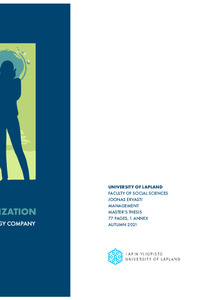Becoming a design-driven organization – Case study on design transformation in a Nordic energy company
Ervasti, Joonas (2021-12-15)
Ervasti, Joonas
Lapin yliopisto
15.12.2021
Julkaisun pysyvä osoite on
https://urn.fi/URN:NBN:fi-fe2021121560855
https://urn.fi/URN:NBN:fi-fe2021121560855
Tiivistelmä
This master’s dissertation aims to examine practices that enable or disable the implementation of design thinking in an organization. Design thinking as a concept has recently gained popularity in both academic and business environments, especially since the 2010s. Many organizations are adopting design thinking tools in various activities ranging from innovation and product development to customer and employee experience, as well as in internationalization efforts.
In this study, an organization in the energy sector is scrutinized. The research question is: "Which practices enable or disable the adoption of design thinking in an organization?" Previously, it has been shown that processes related to internal communication and legitimization, creation of physical spaces and sharing of internal success stories are crucial. Also, the importance of clear management communication, autonomy of the design function as well as co-existence of both deep and wide design expertise has been suggested.
This study, in turn, applies the practice theory lens, which directs the research interest to the practices that the organizational actors take in their everyday work activities. The study is conducted with a narrative approach: the stories told by the members of the organization are analyzed. Rather than producing broadly generalizable knowledge, the eight, thematic narrative interviews provide the study with a wealth of rich, contextual understanding. The results are presented through narrative writing: based on the identified practices, three fictional stories are constructed, by each respondent type (design manager, design team member, member of a business division).
The results indicate that practices related to increasing design expertise among employees, initiating small pioneer projects, and integrating design terminology with business terminology are the most important enabling practices. On the other hand, practices related to quasi-use of design tools, prioritizing short-term profits at the expense of proper design process, and usage of unreliable facilities in design activities are the most important prohibiting practices. The contribution to existing research is threefold: this study advances the research on how individual companies adopt design thinking in their organization, practice approach enriches the knowledge on design transformations, and finally, a case organization in the less explored energy sector is scrutinized.
In this study, an organization in the energy sector is scrutinized. The research question is: "Which practices enable or disable the adoption of design thinking in an organization?" Previously, it has been shown that processes related to internal communication and legitimization, creation of physical spaces and sharing of internal success stories are crucial. Also, the importance of clear management communication, autonomy of the design function as well as co-existence of both deep and wide design expertise has been suggested.
This study, in turn, applies the practice theory lens, which directs the research interest to the practices that the organizational actors take in their everyday work activities. The study is conducted with a narrative approach: the stories told by the members of the organization are analyzed. Rather than producing broadly generalizable knowledge, the eight, thematic narrative interviews provide the study with a wealth of rich, contextual understanding. The results are presented through narrative writing: based on the identified practices, three fictional stories are constructed, by each respondent type (design manager, design team member, member of a business division).
The results indicate that practices related to increasing design expertise among employees, initiating small pioneer projects, and integrating design terminology with business terminology are the most important enabling practices. On the other hand, practices related to quasi-use of design tools, prioritizing short-term profits at the expense of proper design process, and usage of unreliable facilities in design activities are the most important prohibiting practices. The contribution to existing research is threefold: this study advances the research on how individual companies adopt design thinking in their organization, practice approach enriches the knowledge on design transformations, and finally, a case organization in the less explored energy sector is scrutinized.
Kokoelmat
- Pro gradu -tutkielmat [4888]
